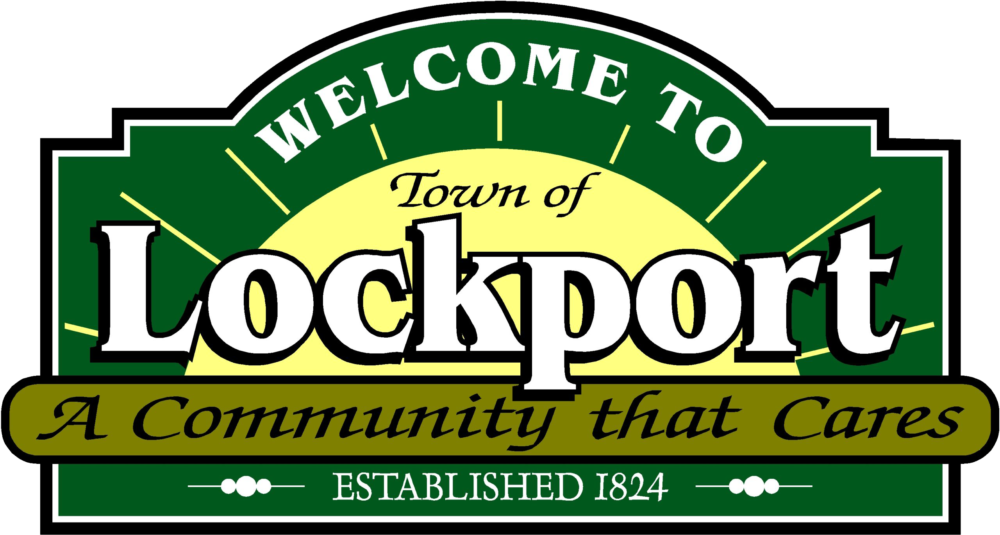Town of Lockport Bicentennial
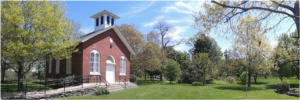
In 2024, the Town will be celebrating its 200th anniversary.
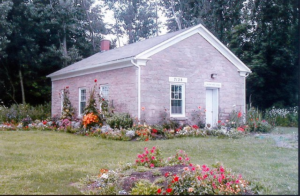 Lockport was formally established on February 2, 1824. There were, however, settlers much earlier. It is said Adam Strouse built the first cabin in Lockport at Cold Spring in 1802. It was a shelter for the mail carrier who travelled between Batavia and Fort Niagara. Shortly thereafter, Charles Wilbur built a tavern for weary travelers.
Lockport was formally established on February 2, 1824. There were, however, settlers much earlier. It is said Adam Strouse built the first cabin in Lockport at Cold Spring in 1802. It was a shelter for the mail carrier who travelled between Batavia and Fort Niagara. Shortly thereafter, Charles Wilbur built a tavern for weary travelers.
Lockport’s formation is intertwined with the Erie Canal. When the exact route of the Canal was determined, a village began to develop in what is now the City of Lockport. Jesse P. Haines surveyed the area, beginning to map lots. With the village quickly progressing, it needed a name. Inspired by the elaborate set of locks which were to be constructed, Haines suggested the name Locksborough for this new village. Dr. Isaac Smith countered with the name Lockport. Residents discussed the names and, unsurprisingly to those of us today, they chose the name Lockport.
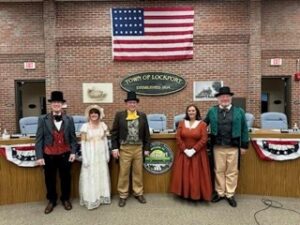
 Construction of the flight of five locks began in 1821. Lockport had a name and a purpose, but it was not officially incorporated as a municipality yet.
Construction of the flight of five locks began in 1821. Lockport had a name and a purpose, but it was not officially incorporated as a municipality yet.
In the Journal of the Assembly of the State of New York, Forty-Seventh Session, January 1824, it was claimed that “the sundry inhabitants of Cambria and Royalton [are] praying for the erection of a town by the name of Lockport.” Their prayers were answered. On February 2, 1824, the town of Lockport was officially established from the eastern section of Cambria and western portion of Royalton.
The first town meeting occurred on the first Tuesday in April of that year at the home of Michael D. Mann; Daniel Washburn was elected supervisor.
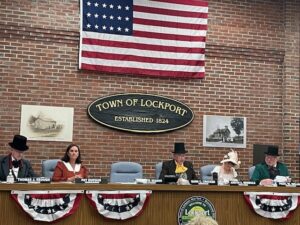
The town’s growth was also connected with the Canal. Tolls were charged for passage through the locks, which resulted in a significant income for the town each year. In addition, harnessing hydropower from the

locks propelled the economy. The locks powered a variety of early industries. The first to take advantage were Jabez Pomroy and William Bass who built a carding mill and Lyman Spalding who constructed a sawmill. The following year, Spalding erected a grist mill.
THESE ARE PHOTOS FROM THE TOWN OF LOCKPORT BICENTENNIAL CEREMONY – First Town Board Meeting Reenactment of 1824 held April 3, 2024
In order to make this the grandest celebration the Town has ever seen; we would love to hear from you. What are your favorite memories of Lockport? Are there stories passed down by your family about the Town or its residents? Do you have photographs, documents or artifacts you would be willing to donate or loan?
If you would like to get involved or have information to share, please reach out to Town Councilperson, Paul Siejak, at townboard_ps@elockport.com or call (716) 478-0609 or the Town Historian, Jean Linn, at jlinn@elockport.com or call (716) 438-2159.
There were more Bicentennial events:
Annual Lock Tenders Tribute Event
On Saturday, May 18, Lockport celebrated the opening of the 2024 Canal Navigation Season!

The event featured…
- Key to the Locks Award Ceremony @ Erie Canal Discovery Center
- Lock Tenders Tribute Procession – Procession to the Locks departs from Erie Canal Discovery Center for ceremony at Lock Tenders Tribute Monument in the Lockport Locks
- Flight of Five Lock Demonstrations
In celebration of the Bicentennial of the Town of Lockport, members of the Town of Lockport Board served as Guest Lock Tenders.
Below are pictures of the day’s events

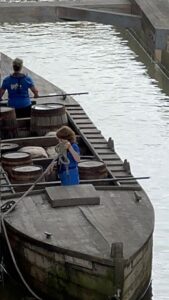


The Community can still enjoy an experience on a Flight of Five Lock Tender Tour
Now Through September 15, 2024

CALL FOR RESERVATIONS: (716) 349-7998
DEPARTING TIMES: 10 am and 12 pm Mondays through Fridays as well as 10 am (ONLY) on Saturdays and Sundays
Join us to celebrate the 2024 Canal Navigation Season!
Admission:
$12 per Adult
$10 per Senior Citizens, Veterans and AAA Members
$ 8 Student Rate (ages 9-21)
FREE for children 8 years of age and under when accompanied by an adult.
For more information visit https://locksdistrict.com or https://www.discoverlockport.com/ for detailed information about all the activities!
Town of Lockport Residents can use the Coupon for $2 off Admission Fee

FREE MOVIE NIGHT – Day Road Park
On June 21 the Town hosed FREE Movie Night at Day Road Park with the Featured Movie–Migration (2023)

Migration is a 2023 American animated adventure comedy-drama film produced by Illumination and distributed by Universal Pictures. The film was directed by Benjamin Renner, co-directed by Guylo Homsy, and produced by Chris Meledandri, from a screenplay written by Mike White and a story by White and Renner.
The Lockport Community Band played in the park from 7 pm till the movie started. 
Town of Lockport Council Member, Paul Siejak, questions a young lady during the Movie Night’s Town Trivia potion of the evening.
Town of Lockport’s 19th Annual Community Day Celebration – Town Hall
Held July 14 at the Lockport Town Hall (6560 Dysinger Road)
The Recreation Committee worked hard getting ready for the 19th Annual Community Day held Sunday, July 14, at the Lockport Town Hall from 12:00 pm – 4:00 pm.
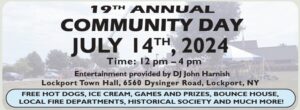
There was ice cream, hot dogs, games for the kids including the ever-popular bounce house.
There was a DJ with great music, firetrucks, and much more!
MORE COMMUNITY EVENTS STILL TO COME!
Christmas in July at Day Road Park! Visit with Santa Claus in the Christmas Cottage!
FREE Community Night
Day Road Park
July 26 from 6:30 to 10 pm
The event will include live music from the Lockport Community Band from 7 to 8:30 pm, with Christmas cookies, snow cones, popcorn, and games until dusk when “The Grinch – the animated version” movie will begin on the big screen in the park!
For information visit the Town’s Facebook page.
Children’s Story Time at Day Road Park
The Lockport Public Library will host Children’s Story Time at Day Road Park!

Weekly story time on Friday mornings from 10 am to 10:30 am featuring stories and songs at the park near the playground.
July 12th
July 19th
July 26th
August 2nd
August 9th
Summer Reading Sponsored by M&T Bank
Enjoy Fitness Sessions in Lockport’s Parks
Now through August Lockport area parks will be hosting different types of exercise classes.

Lockport Day Road Park
Yoga: Mondays 10 am
Thursdays 6:30 pm
Beginners Qigong: Tuesdays 6:30 pm
Zumba: Thursdays 5:45 pm
Goehle Marina (Widewaters) Park
Barre: Sundays 10 am
Pilates: Thursdays 9:30 am
Meditation: Thursdays 10:30 am
Outwater Park
Yoga: Fridays 10 am
One Day Summer Youth Program @ Niagara County Historical Center
RESERVATIONS ARE REQUIRED
Open to all children ages 7 to 12 years old!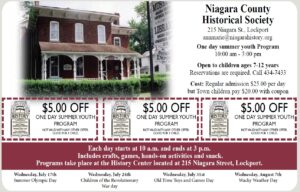
Programs take place at the History Center located at 215 Niagara Street in the City of Lockport.
Call 716-434-7433
Reservation Fee is $25
(Town Residents Admission only $20 per day (with coupons below)
Event Dates:
Wednesday, July 17 – Summer Olympic Day
Wednesday, July 24 – Children of the Revolutionary Way Day
Wednesday, July 31 – Old Time Toys and Games Day
Wednesday, August 7 – Wacky Weather Day
Each day starts at 10 am and ends at 3 pm.
Includes crafts, games, hand-on activities and snack.

Lockport Summer Job Fair – Day Road Park
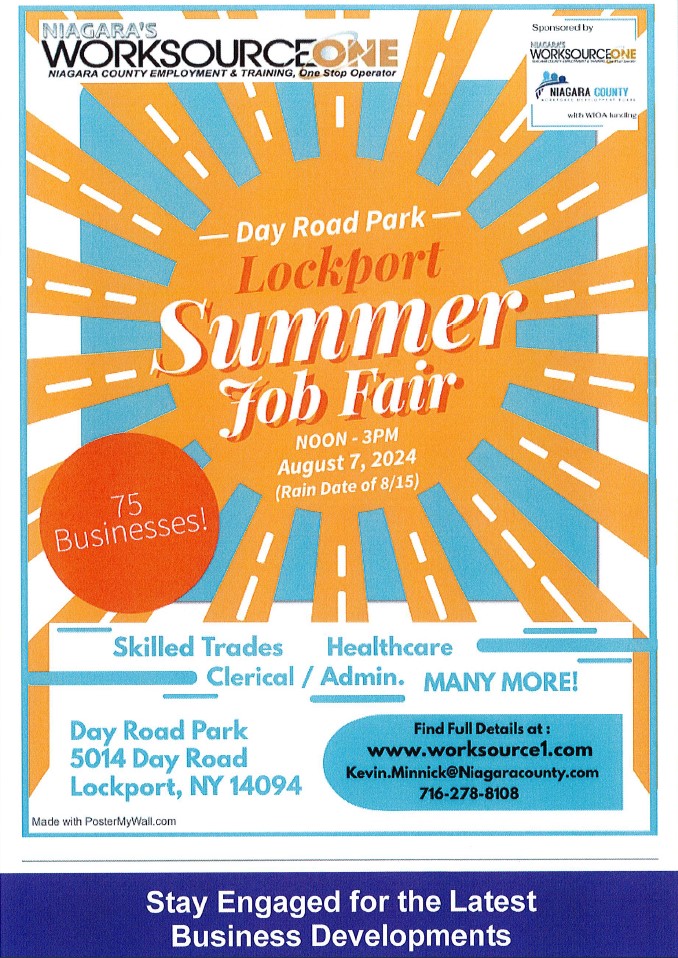
Niagara’s Worksource One, through the Niagara County Employment & Training will sponsor a summertime job fair to be held August 7, 2024, at the Day Road Park from 12 pm to 3 pm (Rain date August 15).
Approximately 75 Businesses will be looking for applicants in the skilled trades, healthcare, clerical, administrative and more.
For full details go to www.worksource1.com
Town of Lockport 2024 Bicentennial & Celebration Committee
Paul Siejak – Town Councilman and Committee Chairperson
Darlene DiCarlo – Town Councilwoman
Judith Newbold – Town Clerk
John Strobel – Chairperson, Recreation Commission
Jean Linn – Town Historian
Meagan Chapman – Vice President Historical Society
Nancy Brooks – Historical Society Board Member
6560 Dysinger Road, Lockport, New York 14094
Tel (716) 439-95200 Fax (716) 439-0528

Town of Lockport, NY
** Certain Fees May Apply **
